Abstract
Curarized and non-curarized rat hemidiaphragm muscles were indirectly stimulated in vitro. 2. The fluid bathing the active curarized muscles was eluted through a dextran gel (Sephadex G-10), effecting a complete separation of ACh from curare. The acetylcholine fraction was then assayed on an isometric leech muscle preparation. 3. Prostaglandin (PGE1) in a concentration fifteen times that estimated to be released from the skeletal muscle preparation did not affect the response of leech muscle to ACh. 4. The amount of ACh released by curarized muscles (4-9 X 10(-18) mole/impulse-junction) was not significantly different from that released by non-curarized muscles (4-6 X 10(-18) mole/impulse-junction). These quantities are similar to those obtained by previous workers. It is concluded that curare in a paralytic dose does not affect the output of ACh from motor nerve terminals stimulated at low frequencies. 5. Spontaneous release of ACh from non-curarized muscles was estimated at 0-45-0-65 p-mole/min. hemidiaphragm. It is calculated that only 2% of this amount could give rise to post-synaptic electrical events, the remainder having a non-synaptic source. 6. The number of molecules of 'quantal' ACh released by stimulated muscle is calculated as 2-5 X 10(6)/impulse-junction, taking account of the non-synaptic release. The number of ACh molecules in one quantum was estimated to be 6250, an amount that could be easily accommodated in one synaptic vesicle.
Full text
PDF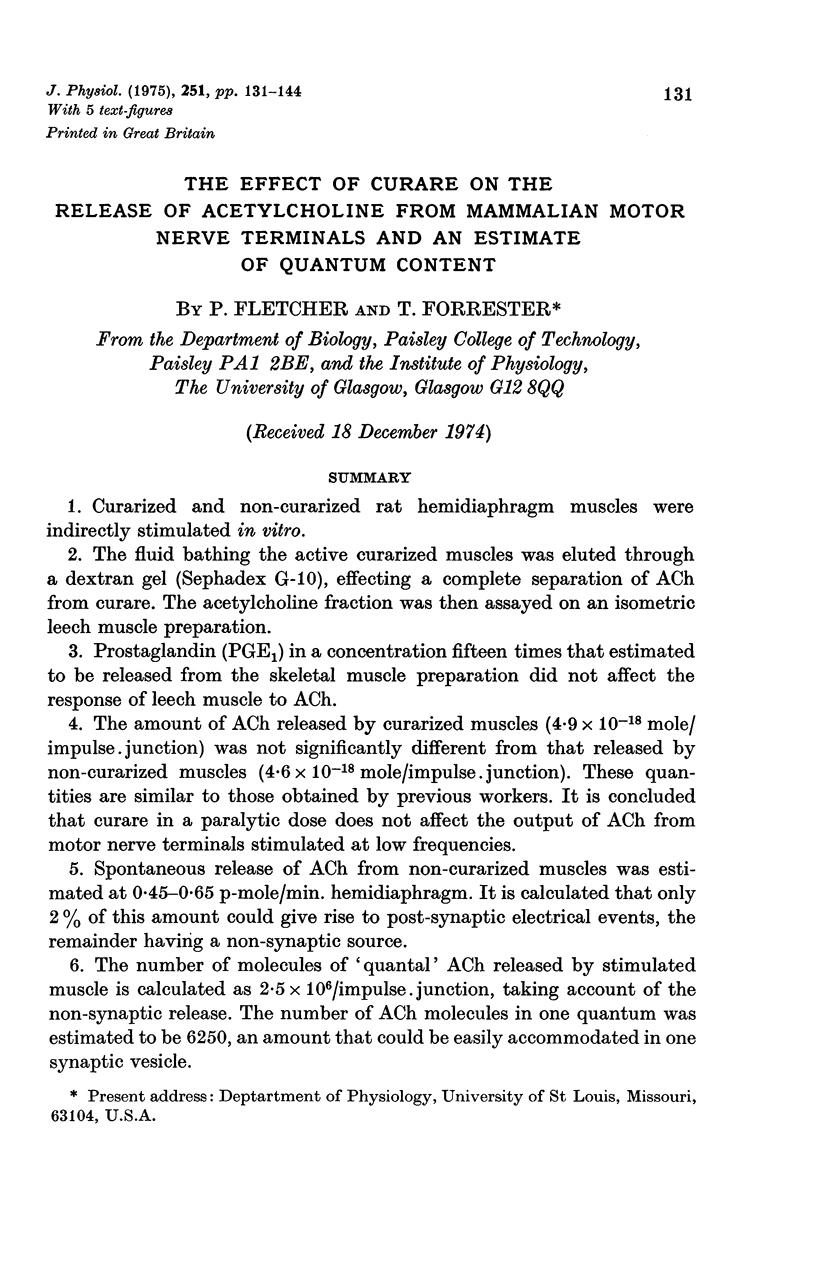
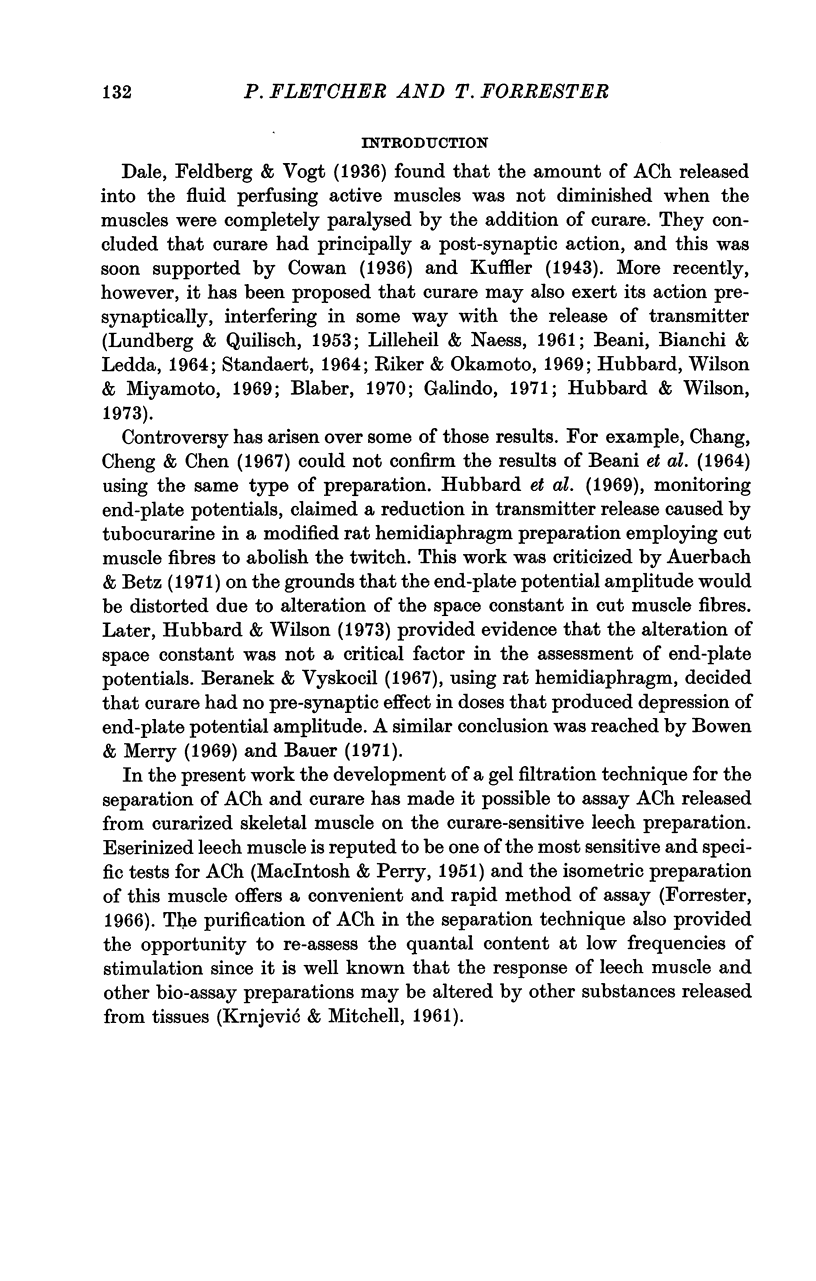
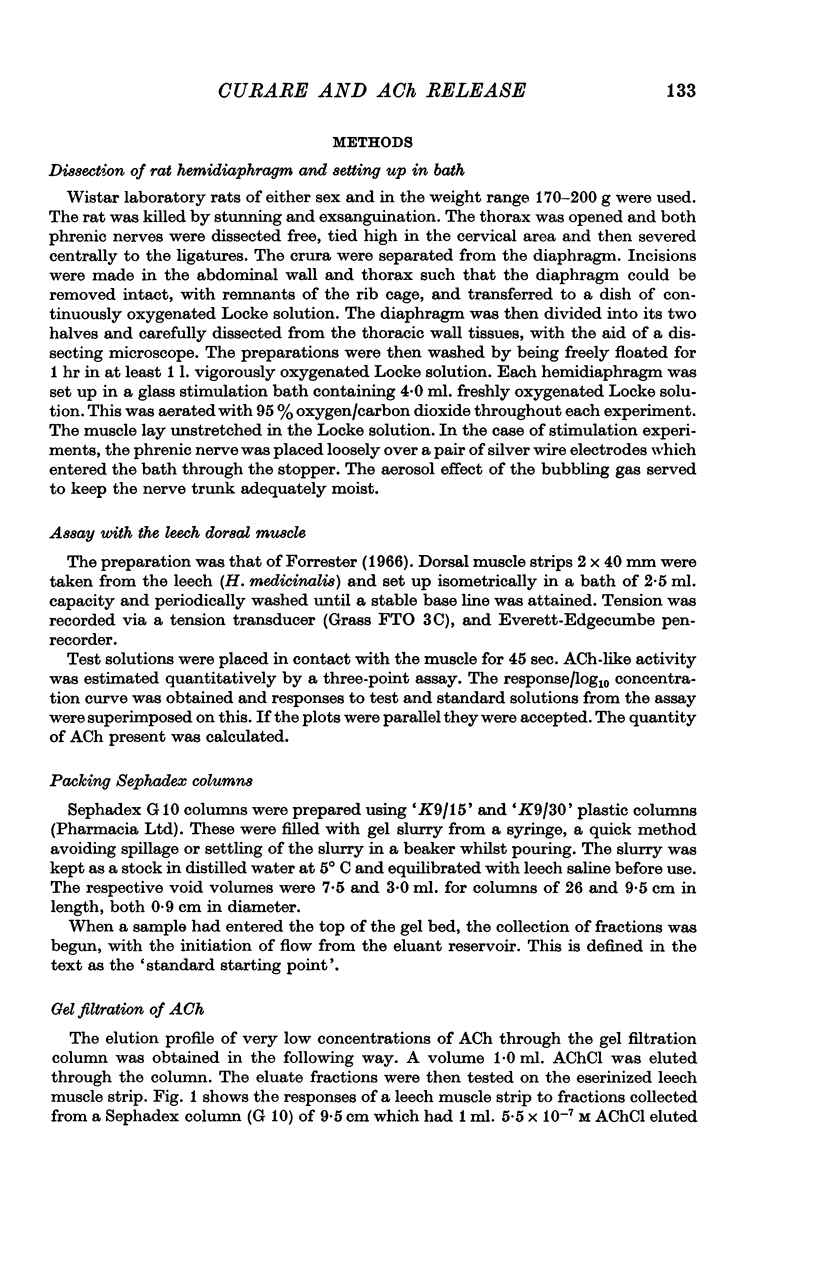
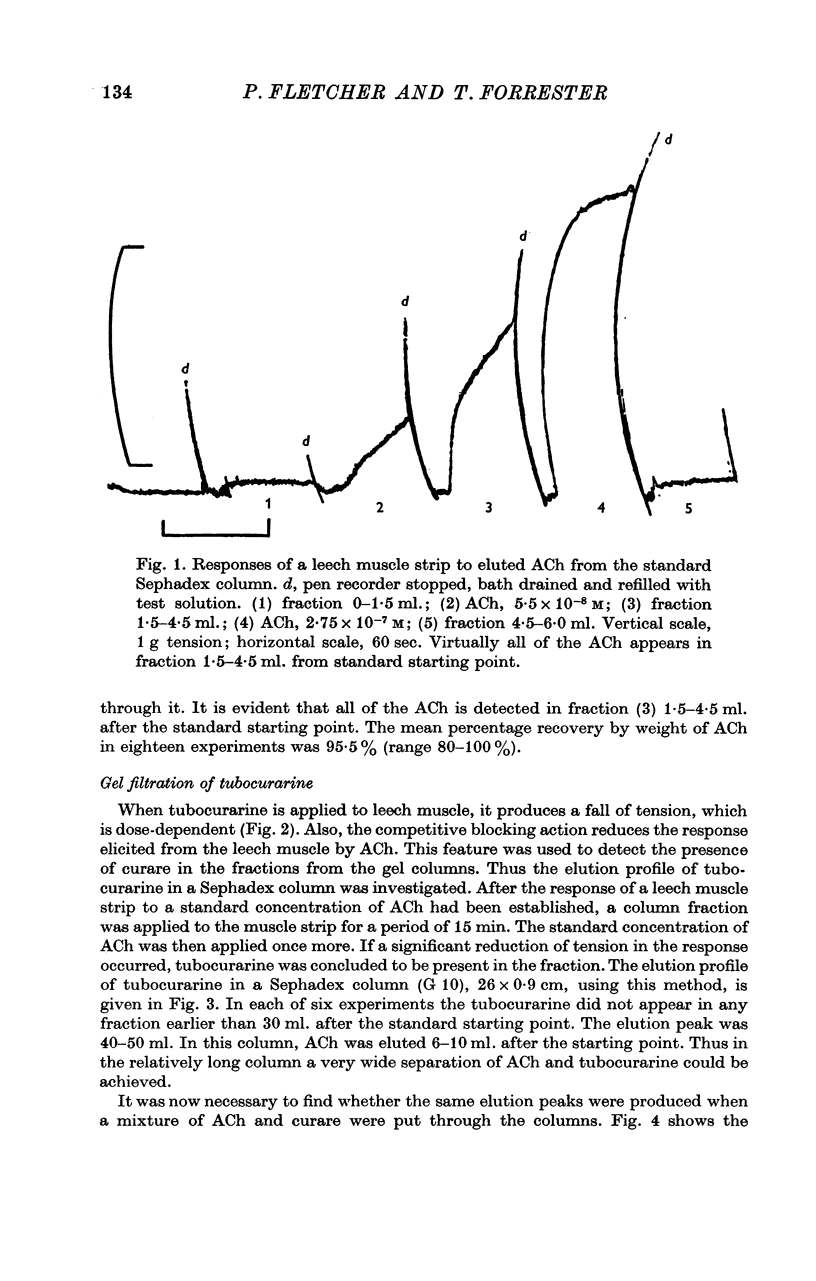

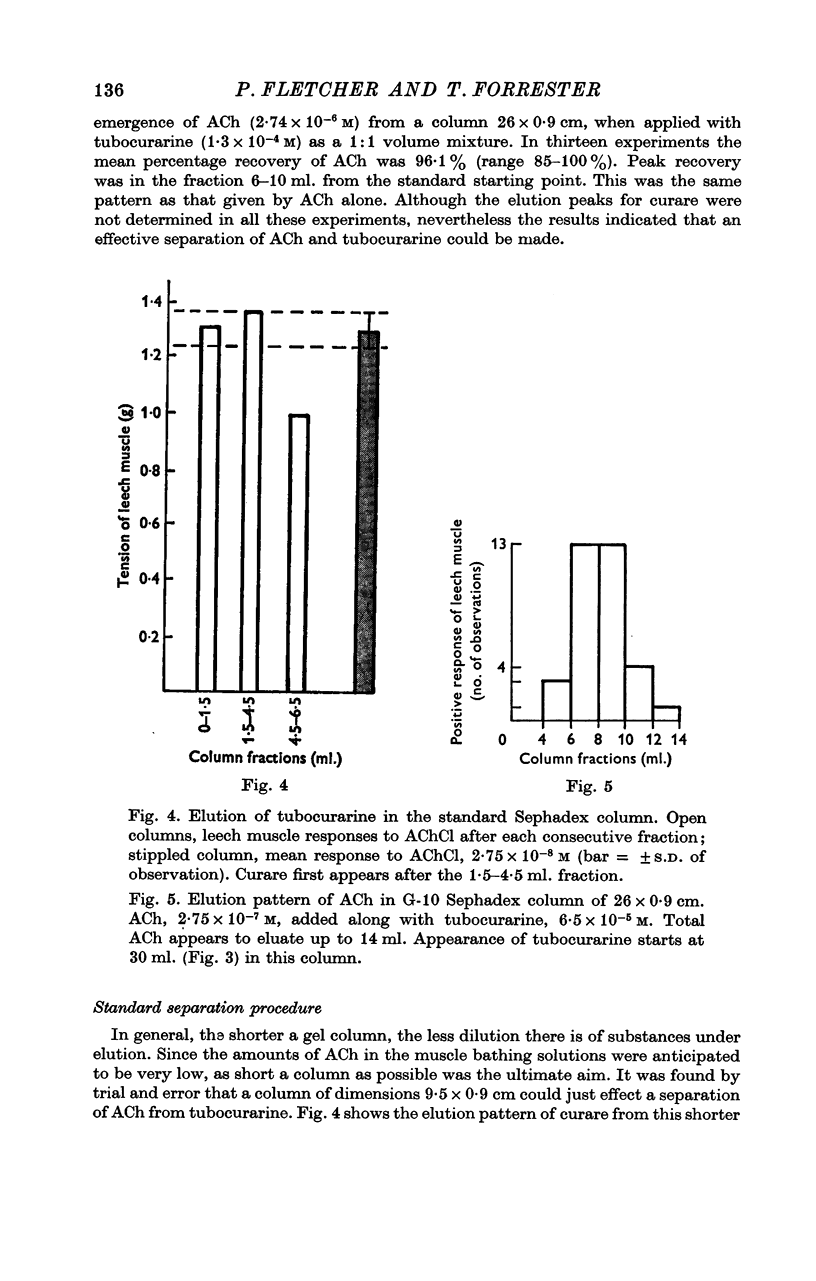
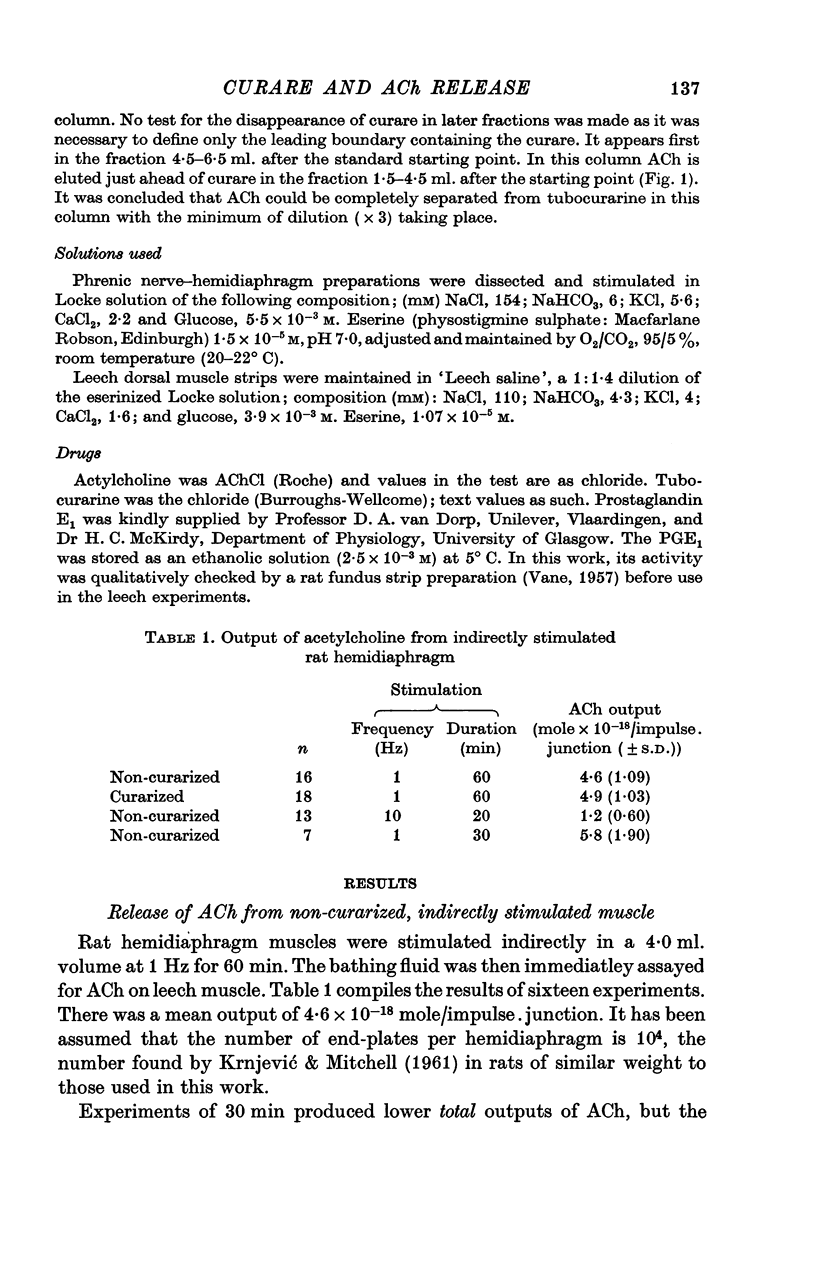
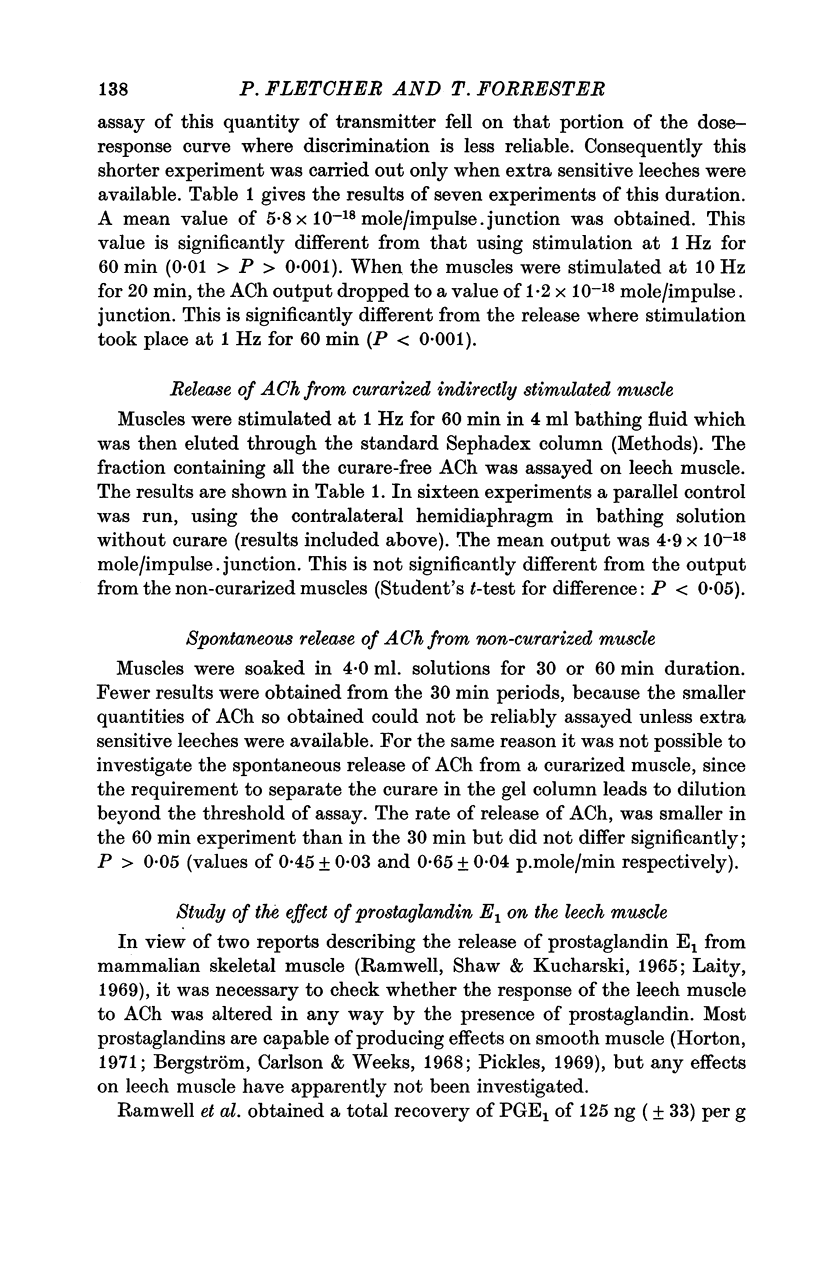
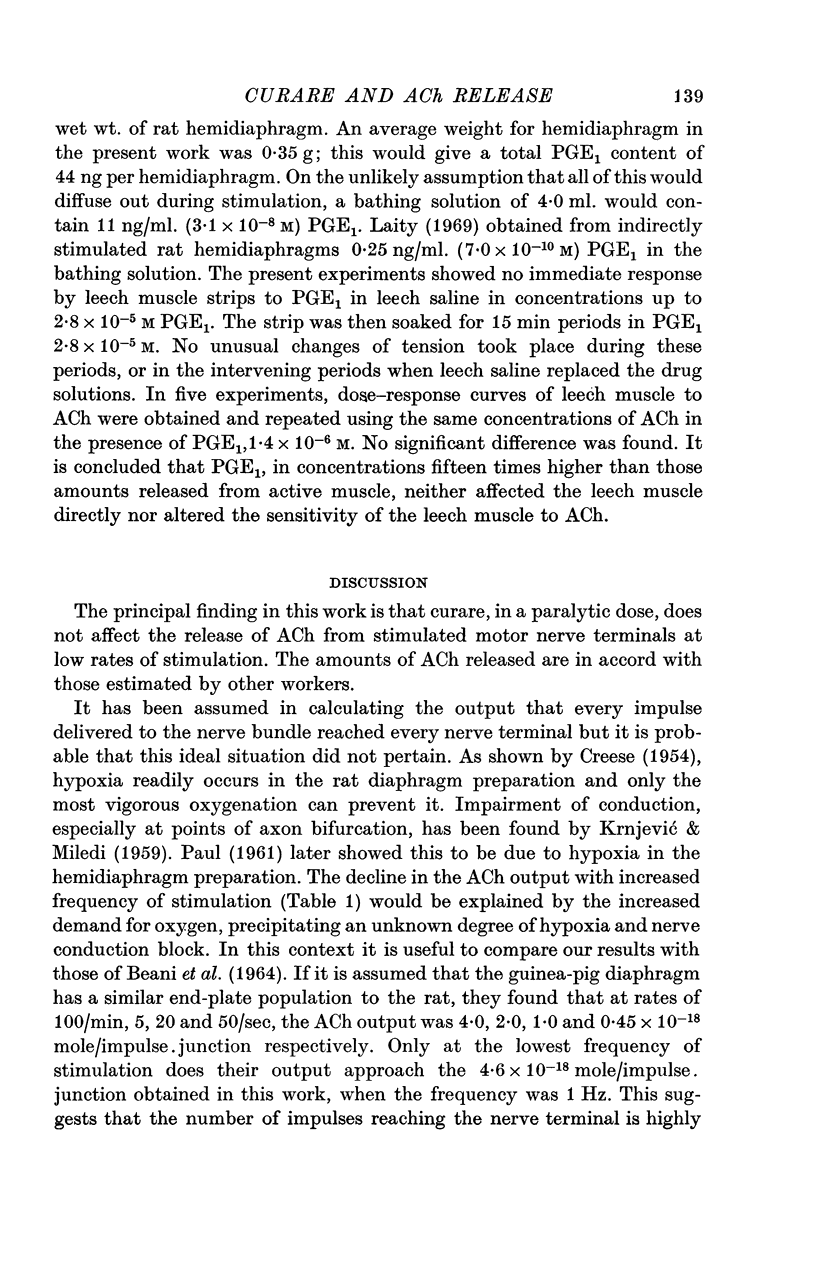
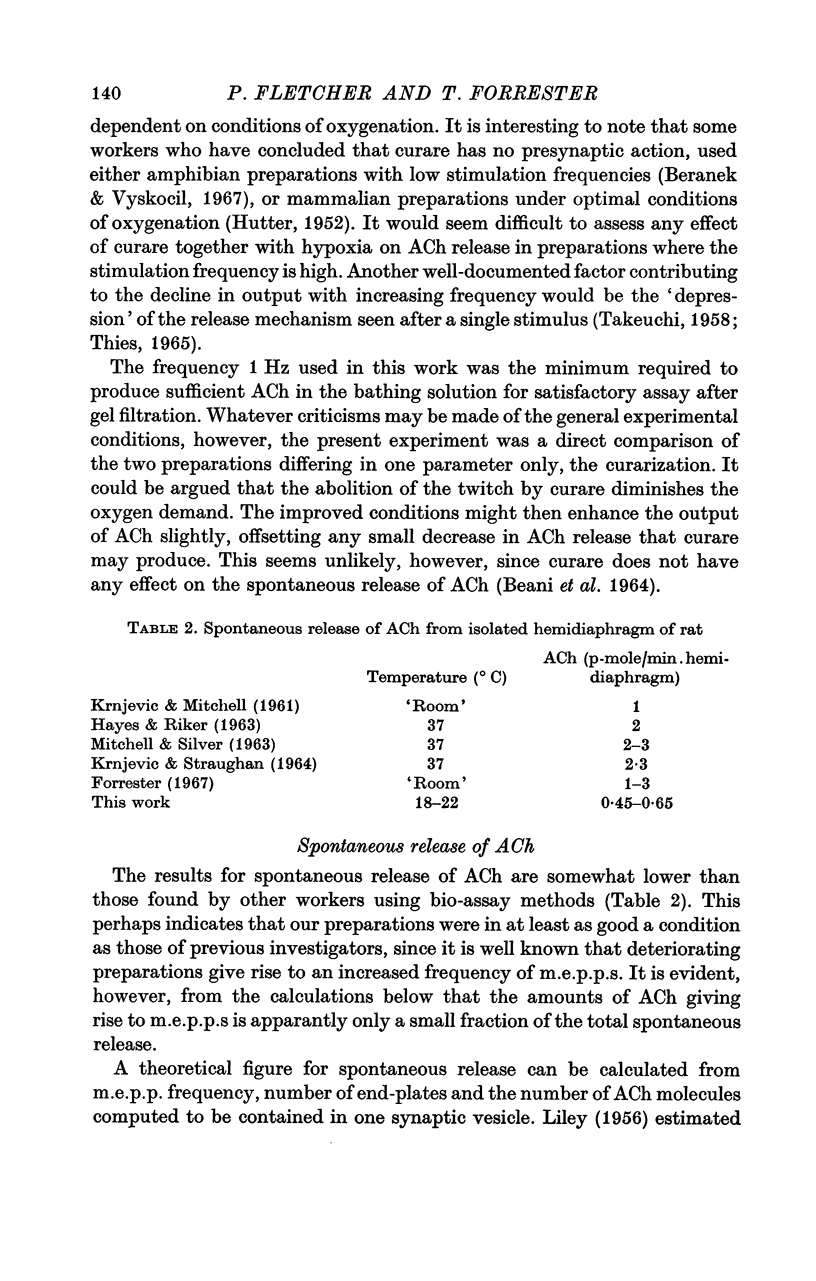
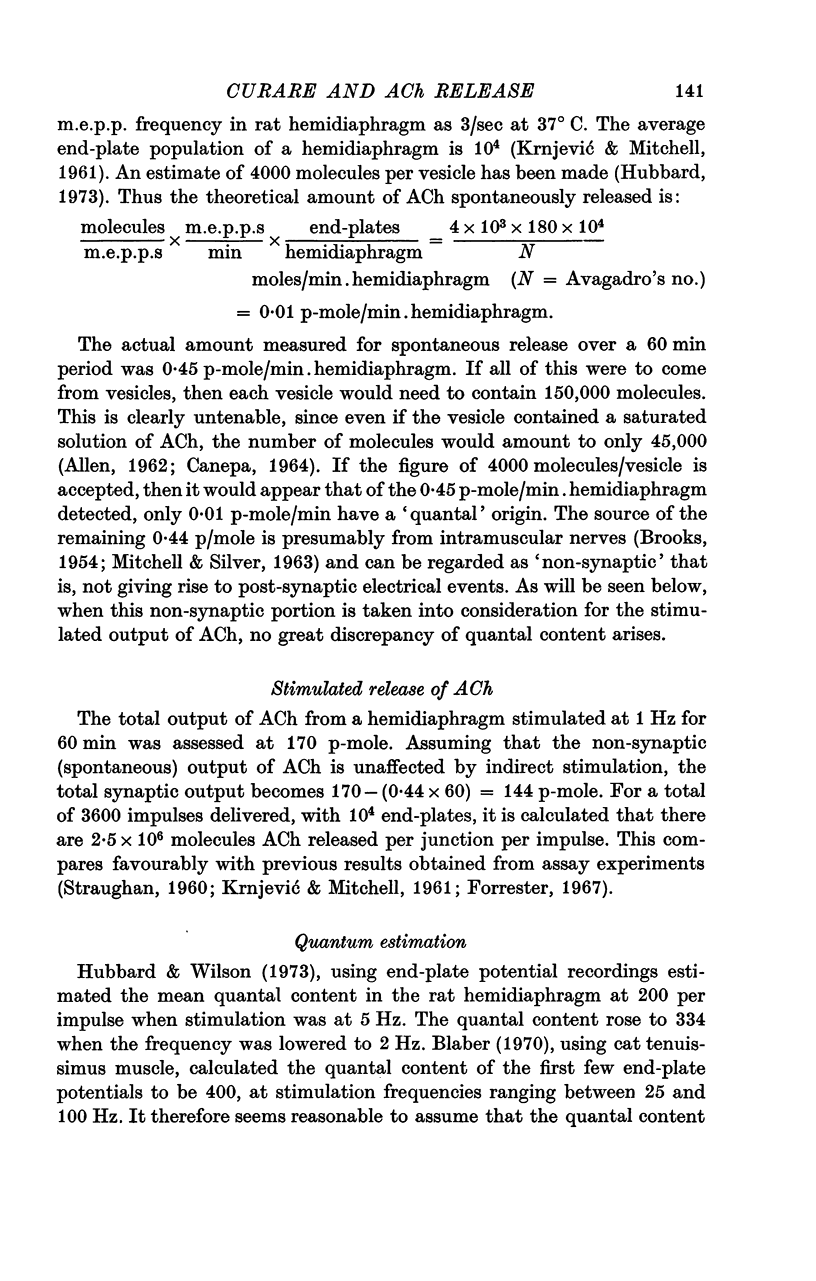
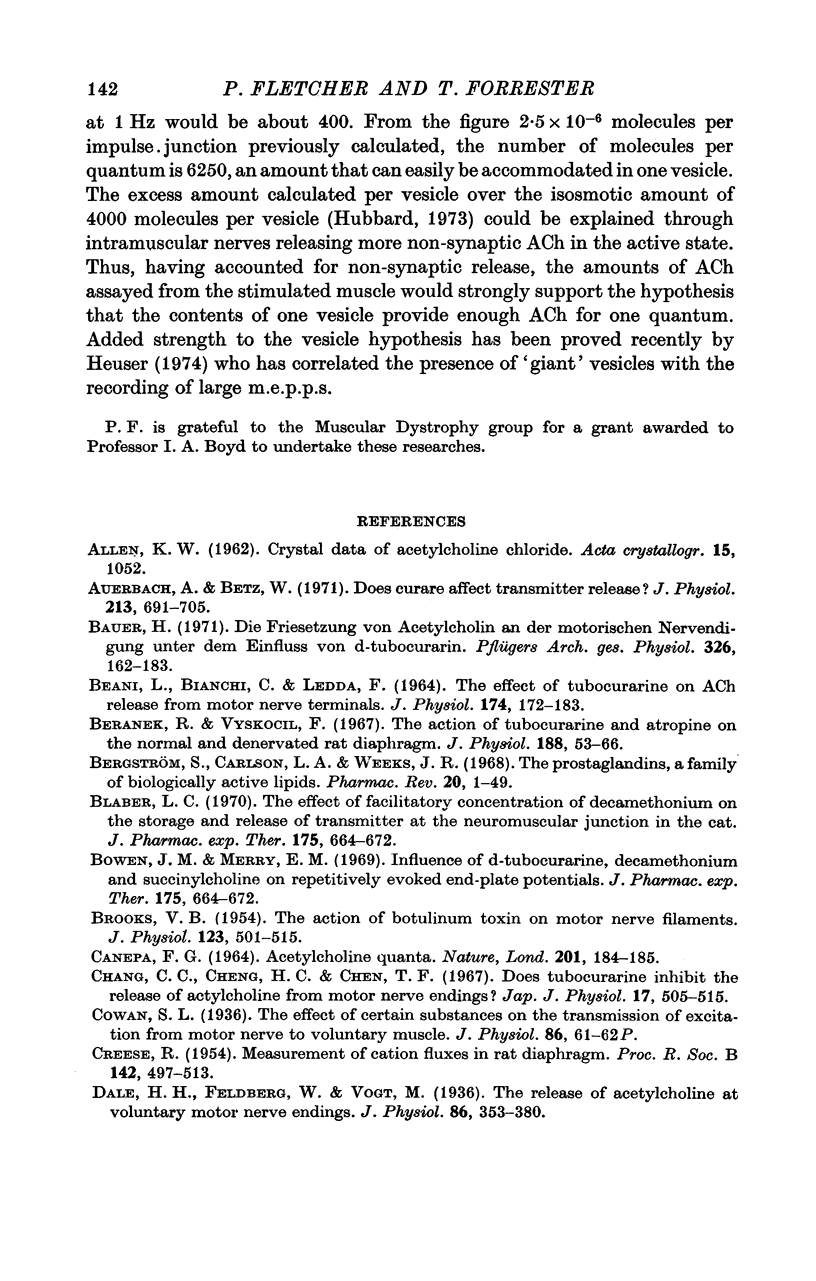
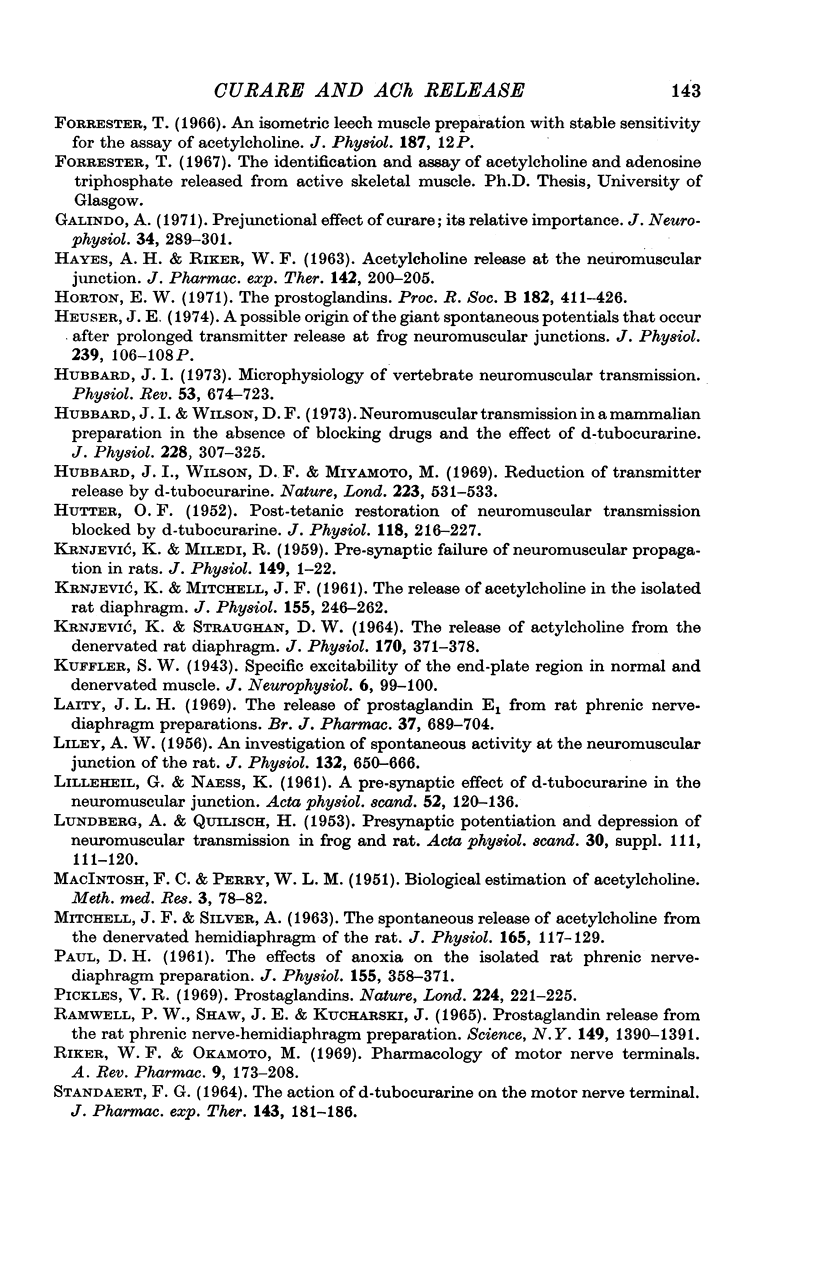
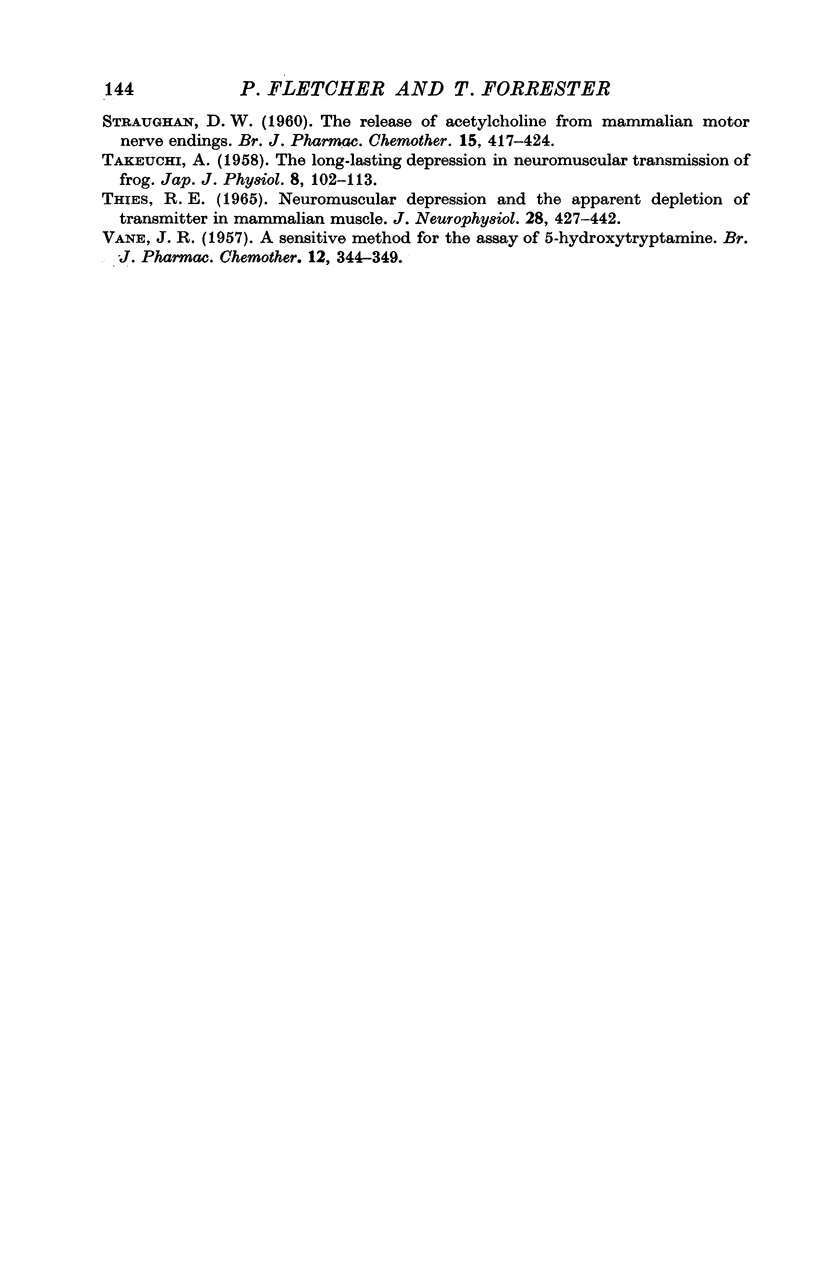
Selected References
These references are in PubMed. This may not be the complete list of references from this article.
- Auerbach A., Betz W. Does curare affect transmitter release? J Physiol. 1971 Mar;213(3):691–705. doi: 10.1113/jphysiol.1971.sp009409. [DOI] [PMC free article] [PubMed] [Google Scholar]
- BEANI L., BIANCHI C., LEDDA F. THE EFFECT OF TUBOCURARINE ON ACETYLCHOLINE RELEASE FROM MOTOR NERVE TERMINALS. J Physiol. 1964 Nov;174:172–183. doi: 10.1113/jphysiol.1964.sp007480. [DOI] [PMC free article] [PubMed] [Google Scholar]
- BROOKS V. B. The action of botulinum toxin on motor-nerve filaments. J Physiol. 1954 Mar 29;123(3):501–515. doi: 10.1113/jphysiol.1954.sp005067. [DOI] [PMC free article] [PubMed] [Google Scholar]
- Bauer H. Die Freisetzung von Acetylcholin an der motorischen Nervenendigung unter dem Einfluss von d-Tubocurarin. Pflugers Arch. 1971;326(2):162–183. doi: 10.1007/BF00586908. [DOI] [PubMed] [Google Scholar]
- Bergström S., Carlson L. A., Weeks J. R. The prostaglandins: a family of biologically active lipids. Pharmacol Rev. 1968 Mar;20(1):1–48. [PubMed] [Google Scholar]
- Beránek R., Vyskocil F. The action of tubocurarine and atropine on the normal and denervated rat diaphragm. J Physiol. 1967 Jan;188(1):53–66. doi: 10.1113/jphysiol.1967.sp008123. [DOI] [PMC free article] [PubMed] [Google Scholar]
- Blaer L. C. The effect of facilitatory concentrations of decamethonium on the storage and release of transmitter at the neuromuscular junction of the cat. J Pharmacol Exp Ther. 1970 Dec;175(3):664–672. [PubMed] [Google Scholar]
- CANEPA F. G. ACETYLCHOLINE QUANTA. Nature. 1964 Jan 11;201:184–185. doi: 10.1038/201184a0. [DOI] [PubMed] [Google Scholar]
- CREESE R. Measurement of cation fluxes in rat diaphragm. Proc R Soc Lond B Biol Sci. 1954 Sep 27;142(909):497–513. doi: 10.1098/rspb.1954.0039. [DOI] [PubMed] [Google Scholar]
- Chang C. C., Cheng H. C., Chen T. F. Does d-tubocurarine inhibit the release of acetylcholine from motor nerve endings? Jpn J Physiol. 1967 Oct 15;17(5):505–515. doi: 10.2170/jjphysiol.17.505. [DOI] [PubMed] [Google Scholar]
- Dale H. H., Feldberg W., Vogt M. Release of acetylcholine at voluntary motor nerve endings. J Physiol. 1936 May 4;86(4):353–380. doi: 10.1113/jphysiol.1936.sp003371. [DOI] [PMC free article] [PubMed] [Google Scholar]
- Galindo A. Prejunctional effect of curare: its relative importance. J Neurophysiol. 1971 Mar;34(2):289–301. doi: 10.1152/jn.1971.34.2.289. [DOI] [PubMed] [Google Scholar]
- HAYES A. H., Jr, RIKER W. F., Jr ACETYLCHOLINE RELEASE AT THE NEUROMUSCULAR JUNCTION. J Pharmacol Exp Ther. 1963 Nov;142:200–205. [PubMed] [Google Scholar]
- HUTTER O. F. Post-tetanic restoration of neuromuscular transmission blocked by D-tubocurarine. J Physiol. 1952 Oct;118(2):216–227. doi: 10.1113/jphysiol.1952.sp004788. [DOI] [PMC free article] [PubMed] [Google Scholar]
- Horton E. W. The prostaglandins. Proc R Soc Lond B Biol Sci. 1972 Dec 5;182(1069):411–426. doi: 10.1098/rspb.1972.0086. [DOI] [PubMed] [Google Scholar]
- Hubbard J. I. Microphysiology of vertebrate neuromuscular transmission. Physiol Rev. 1973 Jul;53(3):674–723. doi: 10.1152/physrev.1973.53.3.674. [DOI] [PubMed] [Google Scholar]
- KRNJEVIC K., MILEDI R. Presynaptic failure of neuromuscular propagation in rats. J Physiol. 1959 Dec;149:1–22. doi: 10.1113/jphysiol.1959.sp006321. [DOI] [PMC free article] [PubMed] [Google Scholar]
- KRNJEVIC K., MITCHELL J. F. The release of acetylcholine in the isolated rat diaphragm. J Physiol. 1961 Feb;155:246–262. doi: 10.1113/jphysiol.1961.sp006625. [DOI] [PMC free article] [PubMed] [Google Scholar]
- KRNJEVIC K., STRAUGHAN D. W. THE RELEASE OF ACETYLCHOLINE FROM THE DENERVATED RAT DIAPHRAGM. J Physiol. 1964 Mar;170:371–378. doi: 10.1113/jphysiol.1964.sp007337. [DOI] [PMC free article] [PubMed] [Google Scholar]
- LILEY A. W. An investigation of spontaneous activity at the neuromuscular junction of the rat. J Physiol. 1956 Jun 28;132(3):650–666. doi: 10.1113/jphysiol.1956.sp005555. [DOI] [PMC free article] [PubMed] [Google Scholar]
- LILLEHEIL G., NAESS K. A presynaptic effect of d-tubocurarine in the neuromuscular junction. Acta Physiol Scand. 1961 Jun;52:120–136. doi: 10.1111/j.1748-1716.1961.tb02208.x. [DOI] [PubMed] [Google Scholar]
- LUNDBERG A., QUILISCH H. Presynaptic potentiation and depression of neuromuscular transmission in frog and rat. Acta Physiol Scand Suppl. 1953;111:111–120. [PubMed] [Google Scholar]
- Laity J. L. The release of prostaglandin E1 from the rat phrenic nerve-diaphragm preparation. Br J Pharmacol. 1969 Nov;37(3):698–704. doi: 10.1111/j.1476-5381.1969.tb08508.x. [DOI] [PMC free article] [PubMed] [Google Scholar]
- Mitchell J. F., Silver A. The spontaneous release of acetylcholine from the denervated hemidiaphragm of the rat. J Physiol. 1963 Jan;165(1):117–129. doi: 10.1113/jphysiol.1963.sp007046. [DOI] [PMC free article] [PubMed] [Google Scholar]
- PAUL D. H. The effects of anoxia on the isolated rat phrenicnerve-diaphragm preparation. J Physiol. 1961 Feb;155:358–371. doi: 10.1113/jphysiol.1961.sp006633. [DOI] [PMC free article] [PubMed] [Google Scholar]
- Pickles V. R. Prostaglandins. Nature. 1969 Oct 18;224(5216):221–225. doi: 10.1038/224221a0. [DOI] [PubMed] [Google Scholar]
- Ramwell P. W., Shaw J. E., Kucharski J. Prostaglandin: release from the rat phrenic nerve--diaphragm preparation. Science. 1965 Sep 17;149(3690):1390–1391. doi: 10.1126/science.149.3690.1390. [DOI] [PubMed] [Google Scholar]
- Riker W. F., Jr, Okamoto M. Pharmacology of motor nerve terminals. Annu Rev Pharmacol. 1969;9:173–208. doi: 10.1146/annurev.pa.09.040169.001133. [DOI] [PubMed] [Google Scholar]
- STANDAERT F. G. THE ACTION OF D-TUBOCURARINE ON THE MOTOR NERVE TERMINAL. J Pharmacol Exp Ther. 1964 Feb;143:181–186. [PubMed] [Google Scholar]
- TAKEUCHI A. The long-lasting depression in neuromuscular transmission of frog. Jpn J Physiol. 1958 Jun 15;8(2):102–113. doi: 10.2170/jjphysiol.8.102. [DOI] [PubMed] [Google Scholar]
- VANE J. R. A sensitive method for the assay of 5-hydroxytryptamine. Br J Pharmacol Chemother. 1957 Sep;12(3):344–349. doi: 10.1111/j.1476-5381.1957.tb00146.x. [DOI] [PMC free article] [PubMed] [Google Scholar]


